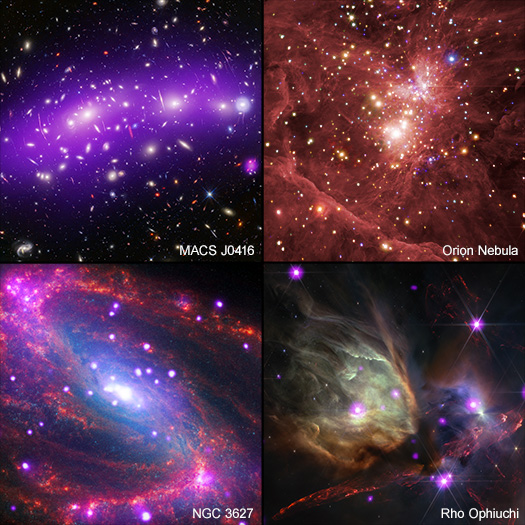Normal Stars & Star Clusters
NASA's Chandra Finds Small Galaxies May Buck the Black Hole Trend

NGC 6278 and PGC 039620
More images, videos, and information
Credit: X-ray: NASA/CXC/SAO/F. Zou et al.; Optical: SDSS; Image Processing: NASA/CXC/SAO/N. Wolk
This two-panel graphic represents the results of a new study that suggests that smaller galaxies do not contain supermassive black holes nearly as often as larger galaxies do. The new study, as described in our latest press release, analyzed over 1,600 galaxies that have been observed with NASA’s Chandra X-ray Observatory over two decades. The findings imply that most smaller galaxies likely do not have supermassive black holes in their centers, which is in contrast with the common idea that nearly every galaxy has one of these giant black holes within their cores.
The two galaxies shown here, NGC 6278 and PGC 039620, are representative of the galaxies in the study. In optical and X-ray images (X-rays are purple), both galaxies are seen in optical light data from the Sloan Digital Sky Survey. The insets contain just the X-ray data from Chandra. NGC 6278 is roughly the same size as our home galaxy and has X-rays detected from its core. PGC 03620 on the other hand is a smaller galaxy — only a fraction of the size of the Milky Way — and does not show any evidence of an X-ray source.
Fall Collection: Before Fall Leaves, See Seasonal Offerings from NASA's Chandra
Before fall gives way to winter in the northern hemisphere, NASA’s Chandra X-ray Observatory has several images that celebrate autumn and its many delights to share. In spirit of the season, this collection gathers Chandra data with those from its telescopic family including NASA’s James Webb, Hubble, and Spitzer Space Telescopes, plus others in space and on the ground.
NASA's Chandra Finds Baby Exoplanet is Shrinking

TOI 1227 / TOI 1227 b
More images, videos, and information
Credit: X-ray: NASA/CXC/RIT/A. Varga et al.; Illustration: NASA/CXC/SAO/M. Weiss; Image Processing: NASA/CXC/SAO/N. Wolk
A star is unleashing a barrage of X-rays that is causing a closely-orbiting, young planet to wither away an astonishing rate, according to a new study using data from NASA’s Chandra X-ray Observatory and described in our latest press release. A team of researchers has determined that this planet will go from the size of Jupiter down to a small, barren world.
NASA Telescopes Deliver Stellar Bouquet in Time for Valentine's Day
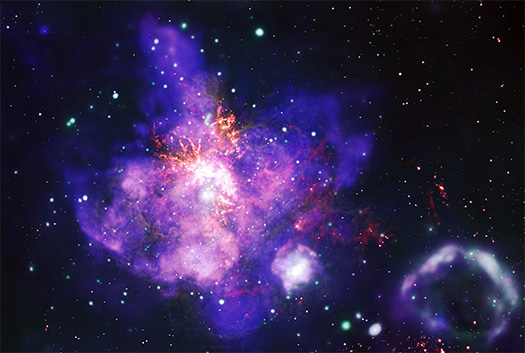
30 Doradus
Credit: X-ray: NASA/CXC/Penn State Univ./L. Townsley et al.; Infrared: NASA/JPL-CalTech/SST;
Optical: NASA/STScI/HST; Radio: ESO/NAOJ/NRAO/ALMA; Image Processing: NASA/CXC/SAO/J. Schmidt, N. Wolk, K. Arcand
A bouquet of thousands of stars in bloom has arrived. This composite image contains the deepest X-ray image ever made of the spectacular star forming region called 30 Doradus.
By combining X-ray data from NASA’s Chandra X-ray Observatory (blue and green) with optical data from NASA’s Hubble Space Telescope (yellow) and radio data from the Atacama Large Millimeter/submillimeter Array (orange), this stellar arrangement comes alive.
Exoplanets Need to be Prepared for Extreme Space Weather, Chandra Finds
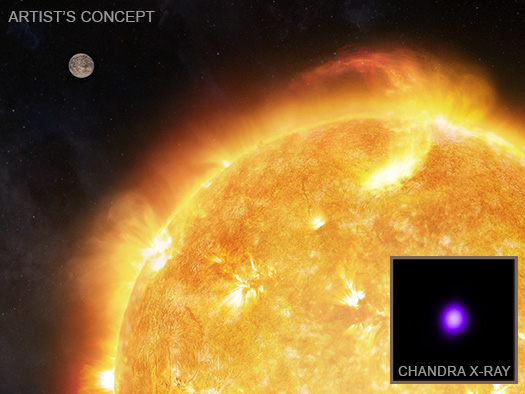
Illustration of Wolf 359 with Chandra X-ray Inset
Credit: X-ray: NASA/CXC/SAO/S.Wolk, et al.; Illustration: NASA/CXC/SAO/M.Weiss; Image processing: NASA/CXC/SAO/N. Wolk
This artist’s illustration represents the results from a new study that examines the effects of X-ray and other high-energy radiation unleashed on potential exoplanets from a host star. As outlined in our latest press release, astronomers using NASA’s Chandra X-ray Observatory and ESA’s XMM-Newton observed Wolf 359, a red dwarf that is only 7.8 light-years from Earth, making it one of the closest stars to the Earth other than the Sun.
The artist’s rendering shows Wolf 359 in the foreground and a potential planet in orbit around it in the background. Red dwarfs are the most common type of star in the Universe. They are much smaller and dimmer than Sun-like stars, which allows them to last for trillions of years. This would give planets in orbit around them ample time for life to form and emerge, which makes them particularly interesting to scientists looking for life beyond the Solar System.
NASA Missions Spot Cosmic 'Wreath' Displaying Stellar Circle of Life
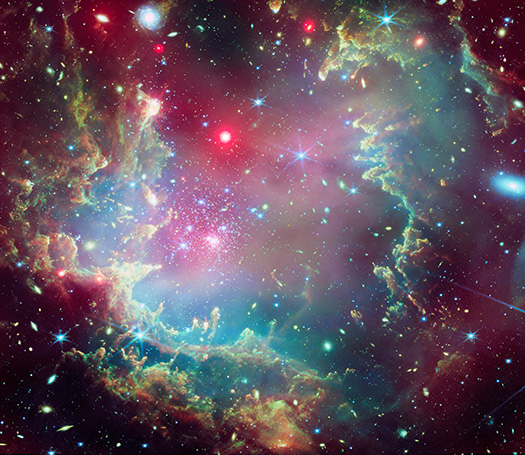
NGC 602
Credit: X-ray: NASA/CXC; Infrared: ESA/Webb, NASA & CSA, P. Zeilder, E.Sabbi, A. Nota, M. Zamani;
Image Processing: NASA/CXC/SAO/L. Frattare and K. Arcand
Since antiquity, wreaths have symbolized the cycle of life, death, and rebirth. It is fitting then that one of the best places for astronomers to learn more about the stellar lifecycle resembles a giant holiday wreath itself.
The star cluster NGC 602 lies on the outskirts of the Small Magellanic Cloud, which is one of the closest galaxies to the Milky Way, about 200,000 light-years from Earth. The stars in NGC 602 have fewer heavier elements compared to the Sun and most of the rest of the galaxy. Instead, the conditions within NGC 602 mimic those for stars found billions of years ago when the universe was much younger.
Planets Beware: NASA Unburies Danger Zones of Star Cluster
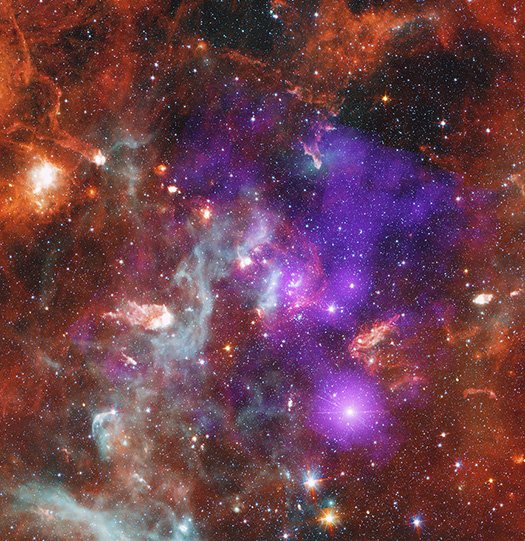
Cyg OB2
Credit: X-ray: NASA/CXC/SAO/J. Drake et al, IR: NASA/JPL-Caltech/Spitzer;
Image Processing: NASA/CXC/SAO/N. Wolk
Most stars form in collections, called clusters or associations, that include very massive stars. These giant stars send out large amounts of high-energy radiation, which can disrupt relatively fragile disks of dust and gas that are in the process of coalescing to form new planets.
A team of astronomers used NASA’s Chandra X-ray Observatory, in combination with ultraviolet, optical, and infrared data, to show where some of the most treacherous places in a star cluster may be, where planets’ chances to form are diminished.
The target of the observations was Cygnus OB2, which is the nearest large cluster of stars to our Sun — at a distance of about 4,600 light-years. The cluster contains hundreds of massive stars as well as thousands of lower-mass stars. The team used long Chandra observations pointing at different regions of Cygnus OB2, and the resulting set of images were then stitched together into one large image.
Take a Summer Road Trip Through Images with NASA's Chandra, Webb
It’s time to take a cosmic road trip using light as the highway and visit four stunning destinations across space. The vehicles for this space get-away are NASA’s Chandra X-ray Observatory and James Webb Space Telescope.
In each of the images, which add Chandra data to previously released Webb images, the colors represent different wavelengths of X-ray, optical, or infrared light.
Coming in Hot: NASA's Chandra Checks Habitability of Exoplanets
Your browser does not support the video tag.
A Three-dimensional Map of Stars Near the Sun
Credit: Movie: Cal Poly Pomona/B. Binder; Illustration: NASA/CXC/M.Weiss
This graphic shows a three-dimensional map of stars near the Sun. These stars are close enough that they could be prime targets for direct imaging searches for planets using future telescopes. The blue haloes represent stars that have been observed with NASA’s Chandra X-ray Observatory and ESA’s XMM-Newton. The yellow star at the center of this diagram represents the position of the Sun. The concentric rings show distances of 5, 10, and 15 parsecs (one parsec is equivalent to roughly 3.2 light-years).
Astronomers are using these X-ray data to determine how habitable exoplanets may be based on whether they receive lethal radiation from the stars they orbit, as described in our latest press release. This type of research will help guide observations with the next generation of telescopes aiming to make the first images of planets like Earth.
'Super' Star Cluster Shines in New Look From NASA's Chandra

Westerlund 1
Credit: X-ray: NASA/CXC/INAF/M. Guarcello et al.; Optical: NASA/ESA/STScI;
Image Processing: NASA/CXC/SAO/L. Frattare
Westerlund 1 is the biggest and closest “super” star cluster to Earth. New data from NASA’s Chandra X-ray Observatory, in combination with other NASA telescopes, is helping astronomers delve deeper into this galactic factory where stars are vigorously being produced.
This is the first data to be publicly released from a project called the Extended Westerlund 1 and 2 Open Clusters Survey, or EWOCS, led by astronomers from the Italian National Institute of Astrophysics in Palermo. As part of EWOCS, Chandra observed Westerlund 1 for about 12 days in total.


